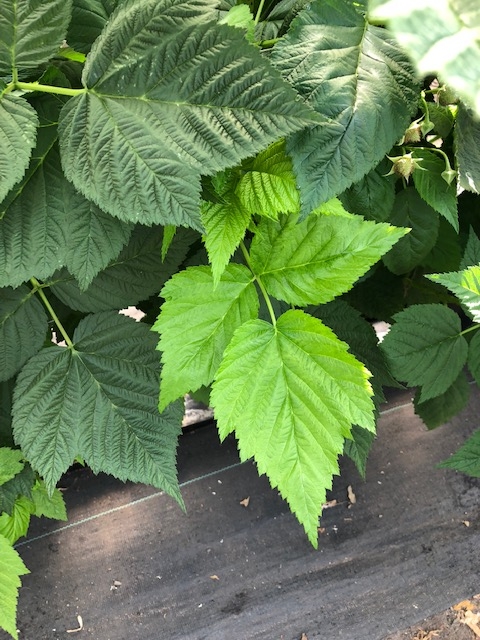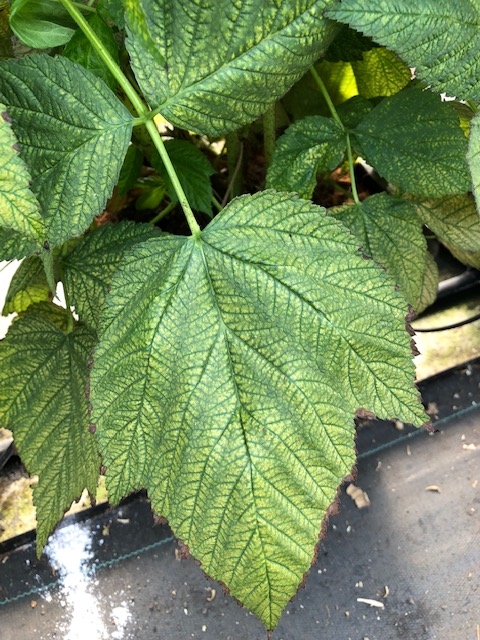Farm Call: Yellow Leaves in Substrate Raspberries
Part of my work has come to include substrate production of caneberries. Some of these are easy since they are pest management issues which don't vary that much from field problems, but others, like the nutritional situation depicted below, are far more complex.
A couple of things going on in this field, which are raspberries being grown in substrate under macro-tunnels. First, the very young leaves have a light yellow cast (see photo one below) to them and second the older leaves are seeming to have some difficulty (see second picture below), again becoming a sterner sort of yellow. I don't worry as much about the older leaves as I do the newer ones, which after all represent the future of the plant.
As you know, I'm not making any call without doing some thorough sampling. In this case, we took multiple samples of the younger leaves demonstrating the lighter shade of yellow and the same for the older yellowed leaves. To set the baseline, adult normal leaves (those surrounding the yellow leaves in the first picture below) were also sampled in multiple.
An important comment. We are sampling leaves of 3 different ages, and we should be aware that this is going to distort some of the concentrations. For example N, P, and K as plant mobile will by default trend higher in younger leaves, and nutrients such as Ca and B are going to trend higher in the older.
And sure enough in perusing the analysis below, N,P and K are higher in our newest leaves and lowest in the older, with the adult leaves in between. Likewise, Ca and B are very much higher in the oldest leaves than the other two age leaves, and as a matter of fact in the newest leaves these two nutrients are lower than what one normally would see recommended.
| Mineral | Adult normal leaf | New, yellow | Old, yellow |
| N (%) | 3.1 | 3.6 | 2.3 |
| P (%) | 0.21 | 0.32 | 0.20 |
| K (%) | 1.6 | 2.3 | 2.1 |
| Ca (%) | 0.9 | 0.6 | 1.4 |
| Mg (%) | 0.5 | 0.4 | 0.7 |
| Na (%) | 0.02 | 0.02 | 0.03 |
| Fe (ppm) | 503 | 336 | 1321 |
| B (ppm) | 33 | 20 | 78 |
| Zn (ppm) | 23 | 28 | 23 |
| Cu (ppm) | 4.1 | 5.8 | 3.7 |
| Mn (ppm) | 343 | 321 | 469 |
Moving on however to the levels of iron things get a bit more interesting. While it is highly accumulated in the oldest leaves, it is far less so in the youngest at 4x less, and 3x in the normal adult leaves. Calcium shows a similar pattern of concentration, but the visual symptoms are nothing like what we know calcium deficiency to look like. Iron deficiency, on the other hand, usually described as chlorosis of one type of another, as a matter of fact does. In addition, we know that nitrogen can accentuate iron deficiencies because of growth promotion.
The older leaves turning yellow? It seems to me they are just old leaves, might be some dieback being pushed by high tunnel heat but nothing that excites a lot of attention.
In other words, it looks like the plant is outgrowing its ability to pull up iron for the moment. Given that we've had (still in October of all things!) some pretty hot plant growth weather, once the weather cools down a lot of this should disappear.
My advice to the grower is watch this one, I'm not sure yet concrete action is merited yet, best to see if once the plant slows down in its growth and nitrogen accumulation these symptoms subside.

Note the contrast of these newer leaves to the midtier leaves around them. Not an plant mobile nutrient, like NPK, so what could be the issue?

On the other hand, many of the very oldest leaves were showing these symptoms, which look a lot like heat or salt damage.
Comments:
Mark
I have had some time to review this. You are indeed right, in both the 6/22/2013 post and this one K is quite a bit higher in the new leaves than the older ones. However, in reviewing one of my plant nutrition books (the very accessible "Plant Nutrition and Soil Fertility Manual" by J. Benton Jones, Jr.), K actually increases the mobility and solubility of Fe, which sounds like it would be the opposite of what we see here.
So, I would still stand on N outrunning the ability of the plant to move Fe to these new leaves, rather than an inhibition brought about by high K.
Really appreciate the input and close reading!
Normal fruiting cycle.
Mark
You can subscribe to this blog simply by going to the “subscribe” link on the left side of this blog.
Let me know if that doesn’t work and I’ll help you figure it out.
Mark


Posted by Thom Flewell on November 5, 2018 at 10:40 PM